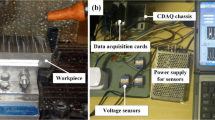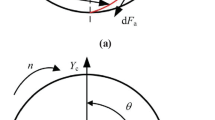Abstract
Establishing a rapid, accurate, and practical energy consumption evaluation model for machine tools is essential to save energy and increase profits in the manufacturing industry. Relationships between spindle rotation speed, cutting parameters, material removal rate, specific energy consumption, cutting power, and material removal power were experimentally analyzed, and the limitation and the limitation and differences between several machine tools’ cutting power evaluation models were discussed. Cutting parameters or material removal rate were regarded as independent variable in those models. By comparing the models’ fitting and predicted results, it draw a conclusion that the model treating cutting parameters as independent variable had greater accuracy but depends on a large quantity of experimental data. The model treating material removal rate as independent variable can also obtain a good fit and reduce the number of necessary experiments. Therefore, it is a rapid method to estimate the cutting energy consumption of machine tools for the latter model. In addition, the paper puts forward an improved cutting power model, which considers the influence of the spindle rotation speed on the material removal power during the milling process. The proposed model can predict a milling machine’s cutting power more accurately.
Similar content being viewed by others
References
Peng T, Xu X (2014) Energy-efficient machining systems: a critical review. Int J Adv Manuf Technol 72(9–12):1389–1406. doi:10.1007/s00170-014-5756-0
US Energy Information Administration (EIA) Annual Energy outlook 2015 with projections to 2040, http://www.eia.gov/forecasts/aeo/. Accessed 25 April 2016
National Bureau of Statistics of the People’s Republic of China http://data.stats.gov.cn/adv.htm?m=advquery&cn=C01. Accessed 25 April 2016
Cao HJ, Li HC, Du YB, Li XG (2012) Current situation and development trend of low-carbon manufacturing. Aeronaut Manuf Technol 9:26–31. doi:10.16080/j.issn1671-833x.2012.09.014 (in Chinese)
Zhou LR, Li JF, Li FY, Meng Q, Li J, Xu XS (2016) Energy consumption model and energy efficiency of machine tools: a comprehensive literature review. J Clean Prod 112(Part 5):3721–3734. doi:10.1016/j.jclepro.2015.05.093
Duflou JR, Sutherland JW, Dornfeld D, Herrmann C, Jeswiet J, Kara S, Hauschild M, Kellens K (2012) Towards energy and resource efficient manufacturing : a processes and systems approach. CIRP Ann Manuf Technol 61(2):587–609. doi:10.1016/j.cirp.2012.05.002
Ma J, Ge X, Chang SI, Lei S (2014) Assessment of cutting energy consumption and energy efficiency in machining of 4140 steel. Int J Adv Manuf Technol 74:1701–1708
Gutowski T, Dahmus J, Thiriez A (2006) Electrical energy requirements for manufacturing processes. In: 13th CIRP international conference on life cycle engineering, Leuven, Belgium, pp. 623–628
ISO14955-1:2014. http://www.iso.org/iso/catalogue_detail?csnumber=55294. Accessed 25 April 2016
Zhang YJ (2014) Energy efficiency techniques in machining process: a review. Int J Adv Manuf Technol 71(5–8):1123–1132. doi:10.1007/s00170-013-5551-3
Sebastian T (2012) Energy Efficiency in Manufacturing systems. Springer, Germany
Mori M, Fujishima M, Inamasu Y, Oda Y (2011) A study on energy efficiency improvement for machine tools. CIRP Ann Manuf Technol 60(1):145–148. doi:10.1016/j.cirp.2011.03.099
Liu F, Liu S (2012) Multiperiod energy model of electromechanical main driving system during the service process of machine tools. J Mech Eng 21:132–140 (in Chinese)
Lv JX, Tang RZ, Jia S (2014) Therblig-based energy supply modeling of computer numerical control machine tools. J Clean Prod 65:168–177. doi:10.1016/j.jclepro.2013.09.055
Zhong QQ, Tang RZ, Lv JX, Jia S, Jin MZ (2016) Evaluation on models of calculating energy consumption in metal cutting processes: a case of external turing process. Int J Adv Manuf Technol 82:2087–2099
Munoz AA, Sheng P (1995) An analytical approach for determining the environmental impact of machining processes. J Mater Process Technol 53(3–4):736–758. doi:10.1016/0924-0136(94)01764-r
Kishawy HA, Kannan S, Balazinski M (2004) An energy based analytical force model for orthogonal cutting of metal matrix composites. CIRP Ann Manuf Technol 53(1):91–94
Shao H, Wang HL, Zhao XM (2004) A cutting power model for tool wear monitoring in milling. Int J Mach Tools Manuf 44(14):1503–1509. doi:10.1016/j.ijmachtools.2004.05.003
Yoon HS, Lee JY, Kim MS, Ahn SH (2014) Empirical power-consumption model for material removal in three-axis milling. J Clean Prod 78:54–62. doi:10.1016/j.jclepro.2014.03.061
Gutowski T, Branham M, Dahmu J, Jones A, Thiriez A (2009) Thermodynamic analysis of resources used in manufacturing processes. Environ Sci Technol 43(5):1584–1590. doi:10.1021/es8016655
Kara S, Li W (2011) Unit process energy consumption models for material removal processes. CIRP Ann Manuf Technol 60(1):37–40. doi:10.1016/j.cirp.2011.03.018
Diaz N, Redelsheimer E, Dornfeld D (2011) Energy consumption characterization and reduction strategies for milling machine tool use. Glocalized Solutions for Sustainability in Manufacturing—Proceedings of the 18th CIRP International Conference on Life Cycle Engineering. Springer Science and Business Media, LLC, pp 263–267. doi: 10.1007/978-3-642-19692-8-46
Li L, Yan JH, Xing ZW (2013) Energy requirements evaluation of milling machines based on thermal equilibrium and empirical modelling. J Clean Prod 52:113–121. doi:10.1016/j.jclepro.2013.02.039
Guo YS, Loenders J, Duflou J, Lauwers B (2012) Optimization of energy consumption and surface quality in finish turning. Procedia CIRP 1(1):512–517. doi:10.1016/j.procir.2012.04.091
Xie J, Liu F, Qiu H (2016) An integrated model for predicting the specific energy consumption of manufacturing processes. Int J Adv Manuf Technol 85(5–8):1339–1346
Jia S, Tang RZ, Lu JX (2013) Therblig-based modeling methodology for cutting power and its application in external turning. Comput Integr Manuf Syst 19(5):1015–1024
Author information
Authors and Affiliations
Corresponding author
Rights and permissions
About this article
Cite this article
Zhou, L., Li, J., Li, F. et al. An improved cutting power model of machine tools in milling process. Int J Adv Manuf Technol 91, 2383–2400 (2017). https://doi.org/10.1007/s00170-016-9929-x
Received:
Accepted:
Published:
Issue Date:
DOI: https://doi.org/10.1007/s00170-016-9929-x




